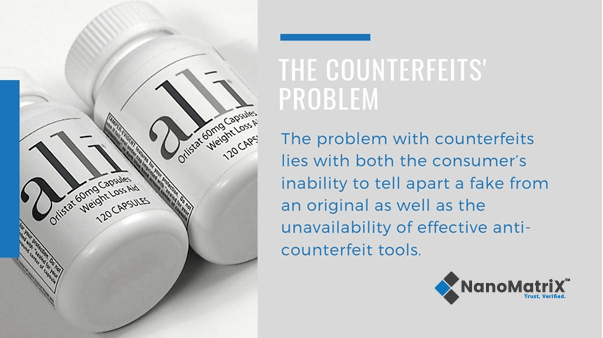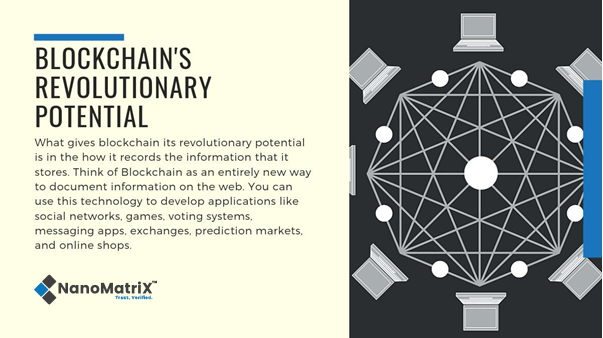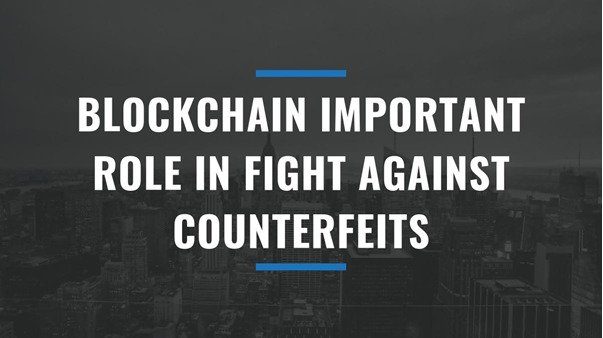How Blockchain Can Play an Important Role in Fight against Counterfeits
Counterfeiting is a trillion-dollar industry. Last year, the U.S. government seized counterfeit luxury goods that can fill 22 shipping containers. They included counterfeit Tory Burch purses, Hermès belts, and Gucci bags and in total were worth $500 million. These fakes originated from China and ended up in warehouses in Queens, New York, and retail outlets in California and Illinois.
Unlike decades ago where counterfeiters were small time illegal businesses that did not have a big impact on the original brands, today’s counterfeiting industry is a complex one and has a devastating effect on many businesses across the globe. The counterfeit market creates an unending demand for new products. This fuels the consumption cycle as consumers seek to look different from the people around them.
But it does not take long before the fake products saturate the market and suddenly become less desirable. For this reason, the consumer has to look for another purchase that will make them stand out. The problem with counterfeits lies with both the consumer’s inability to tell apart a fake from an original and the unavailability of effective anti-counterfeit tools.

Brand protection, anti-counterfeiting programs using blockchain have to select security labels, secure QR codes, TrackMatriX Lock codes or NFC tags
Technologies Currently Available to Fight Counterfeit Products
To combat counterfeits, manufacturers use certain authentication methods to prove that a product is genuine.
One such authentication method that uses a product’s packaging is visual authentication. Visual authentication helps combat counterfeits by ensuring that customers do not unwittingly buy below-par products that ultimately damage a company’s reputation.
Among the downsides of using authentication features in packaging is that counterfeiters can repackage the product using packages with their own authentication features.
Manufacturers use Track and Trace systems to ensure the security of a product and as a way of identifying the introduction of counterfeits in the supply chain. The track-and-trace system includes special labels and barcodes crafted from different materials such as ceramic, polyester, aluminium, and paper.They also often use radio frequency identification. This allows consumers to easily check a product’s authenticity on the internet, building the consumer’s confidence in that product.
One demerit of using track and trace systems is the inability to scale because of the technology’s proprietary nature. Track and trace systems can only communicate with specified readers, meaning that you must have specific readers for specific systems. Another disadvantage of using a track and trace system is the cost associated with it; for SMEs, the cost associated with deploying track and trace systems is often quite high.
Many brands today are using the Internet of Things and near field communication to create smart packaging to fight counterfeits. These smart packages are being used in packaging cosmetics and other FMCGs. They offer consumers additional features that would not be possible to incorporate in normal packaging, giving additional incentives to consumers towards buying original products.
NFC technology in particular increases consumer interaction; users can scan NFC chips that are embedded in the packaging to get access to more product-related information/content including tutorials and videos about how to use the product at hand. This is a noteworthy consumer incentive for buying the original product instead of cheap counterfeits. the Internet of Things can sense that a product is nearing the date of expiration. It sends a notification to the user via their smartphone, prompting them to buy a new product. In addition to serving as an incentive for consumers to buy original products, this also helps brands encourage users to purchase more goods regularly.
The disadvantages of using this technology in the fight against counterfeits include:
- The technology’s ineffectiveness and inefficiency in data transfer rates; it compares poorly to Wi-Fi and Bluetooth.
- The vulnerability to attacks of plain NFC – this technology is vulnerable to eavesdropping or man-in-the-middle attacks because it has no capacity to guarantee secured communications.
- NFC technology is not very ideal when used smartphone and computer applications as a standalone protocol for wireless communication.
- By its very nature IoT collects a massive amount of data that becomes hard to transmit or store.
What Is Blockchain?
A blockchain refers to a public ledger that contains data collected over a particular network on the Internet. What gives blockchain its revolutionary potential is in how it records the information that it stores. Think of Blockchain as an entirely new way to document information on the web. You can use this technology to develop applications like social networks, games, voting systems, messaging apps, exchanges, prediction markets, and online shops, just to mention a few. In a sense, this technology has notable similarities to the Internet.

That is why in some circles it is referred to as The Internet 3.0. Practically any type of information can be recorded on a blockchain. The information could be denoting ownership, a money transfer, a contract between several parties, etc. All the information goes through an authentication process before it can be recorded on the blockchain. It must be authenticated across all the devices within the network.
Once all the devices on the network are in agreement about a particular piece of data, the data is stored on the blockchain unquestionably. This means that it cannot be altered, removed or disputed without going through the exact same process of reaching a consensus with all the devices in the network.
The Growth of Blockchain-Based Products for Different Industries
By design a block chain is a centralized database that runs on millions of computers across the Internet. Blockchain uses modern cryptography that ensures that once data is keyed in, it is virtually impossible to obtain it without using the original key or passcode. Essentially, what this technology does is to establish trust through collaboration and code instead of a centralized authority like a central bank.
Therefore, for things like money transfers, people would no longer need the services of a bank. You would no longer need to have an escrow account when buying a home or hire a real estate agent to facilitate that or any other transaction. This reality is revolutionizing practically every industry there is. The following industries may be leading the way in creating blockchain-based products and innovations.
- Banking – Blockchain technology provides a safer and more secure way of storing banking records as well as a cheaper and faster way to do money transfers.
- Legal industry – Using blockchain in the legal industry eliminates any question of the legality of legal documents like wills.
- Healthcare – Blockchain technology would give doctors, nurses, and other healthcare providers secure and easy access to a patient’s health records remotely.
- Politics – In politics, blockchain has the potential to eliminate voting irregularities and rigged votes, including vote hacking by terrorists or corrupt governments.
The Value of Blockchain Technology and How It’s Different from Other Technologies in the Fight against Counterfeit Products
Blockchain technology is being used by many companies to transform the business processes, especially the production process. Manufacturers are incorporating blockchain in their anti-counterfeiting techniques to help consumers better differentiate between fakes and originals.
They’re taking back control of the supply chain and using blockchain to secure the supply chain from the introduction of counterfeits or the redirection of their goods out of the official chain of supply and into the black market.
From supplier payments to contracts bids, and product traceability, blockchain is doing what many other technologies have been unable to do: make it extremely difficult to introduce fake goods into the supply chain. Indeed, it looks like the blockchain might become the universal operating system for the supply chain, enabling scalability, improving transparency, and increasing security.
In a consumer system that is increasingly uncertain, blockchain offers a way out. It provides a decentralized ledger in which the entire history of any one product or transaction is stored and can be viewed, accessed, and verified from any location worldwide. This makes product authentication easy and seamless. Distributors are excited about this technology because it brings transparency in a globalized market where a product can sometimes be handled by several vendors, other times even changed and repackaged before reaching the market. This increases the difficulty of keeping track of the product and gives counterfeiters a way into the market.
That is why even some of the most respected and ethical brands have at some point also fallen victim to this illegal business. It allows them to store all the information regarding a product in a single record and creates a new and verifiable transaction every time the product changes hands or is transferred to a new location.
What’s more, this information can be made available to consumers, entirely transforming their understanding of a particular product even before they buy it. This essentially means that instead of delegating the vetting process to retailers, blockchain can help move this to consumers who, after all, are the ones who will use the product.
While it is unlikely that blockchain will solve the counterfeiting problem entirely, there’s a clear chance that it will make a dent in this industry that has been growing almost entirely unabated for decades.
How Blockchain Can Solve Current Counterfeiting Problems
It is an accepted fact today that international laws, regulations, cooperation, and enforcement have been quite ineffective in reducing the counterfeit products that get to the consumer. For the most part, this failure revolves around these three areas:
- The ever-increasing scope of products available in the market
- The apparent lack of transparency throughout the supply chain
- The cost of enforcement — both human resources and monetary
The following are ways that blockchain can solve these problems:
As already mentioned, blockchain has the ability to redesign the supply chain. By design, the blockchain is a decentralized ledger in which complete histories of transactions can be stored. This makes tracking a product from manufacturing to the consumer easy and straightforward. Additional innovations in this space are also making it possible to track all links within a supply chain, including freight and transport, distributors, customs, and retailers.
Using blockchain, every medicine bottle or packet is assigned an identifier. The identifier is unique and cryptographically protected. This would ensure a problem like the one reported in 2014 where fake Pfizer medicines were being sold in over 100 countries is never repeated.
For the longest time, creators of intangible assets and intellectual properties have not had an effective way to stop the misuse of their IP or reproduction of their digital files. Blockchain promises to change that. Because of blockchain’s immutable nature, it is now very much possible to create and enforce IP contracts.
The restrictions and rules can be directly coded into a given asset where all the contract stipulations and terms of use are clearly outlined and effectively enforced. In the event that unlawful reproduction or an IP breach happens, it would be possible to immediately tell when and where it happened as well as who orchestrated the breach. What’s more, a predetermined remuneration can be enforced on behalf of all the affected parties.
A chain is no stronger than its weakest link
Blockchain technology is a powerful technology to innovate new digital features of anti-counterfeiting programs. Due to the digital nature of the blockchain technology, such innovations are foremost or exclusively improving the digital processes and features of verifying the authenticity of physical items such as products or documents.
However, a necessity of securely linking a blockchain token with a physical item is applying a unique marking to a specific product or document. To extend the indisputable digital strengths of blockchain technology to physical items, the markings used on products and documents must match the strong security characteristics of the blockchain. Otherwise, the quality of the security system will be severely compromised. In other words, the effectiveness of blockchain-based anti-counterfeiting programs can only be as strong as the resilience of the physical mark against intended criminal attacks.
That is what NanoMatriX offers – the link between the physical product and the digital data through unique tamper proof marks. Our specialisation in blockchain solutions ensures the security of products or documents. Our 15 years of expertise in fighting counterfeit products using the latest technologies listed above makes us extremely competitive, and we have developed a wide range of advanced physical security features to support highly customized anti-counterfeiting programs, effectively addressing the risks corporations of any size or industry are exposed to. Our end-to-end solutions also address contemporary challenges related to product and brand protection.
Essential Characteristics to look out for when investing in Blockchain technology
| Blockchain Characteristics | Product & Document Security Characteristics |
|
|
About NanoMatrtiX
NanoMatrix has initiated a journey to fight against counterfeit products since 2004 by providing secured identification, traceability and authentication solutions and other integrated services to help brand holders. Our products are relevant to multiple sectors such as food, pharmaceuticals, perfumes and cosmetics, leather goods and bags, clothing and textiles, shoes, jewelry, electronic and electrical goods, optical and photographic devices, and toys. With our expertise in fighting counterfeit products and use of latest technologies such as AI, blockchain and IOT, we will provide end-to-end solutions to address contemporary challenges related to product and brand protection. Our aim is to give a ‘one-stop’ solution to our customers to fight against counterfeit products.

